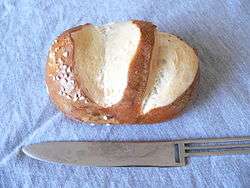Lye roll
 | |
| Type | Bread roll |
|---|---|
| Main ingredients | Bread roll, solution of lye or baking soda |
|
| |
Lye rolls are a baked specialty in Germany (especially in Bavaria and Swabia), Austria, and Switzerland. They are made by immersing bread rolls in a lye solution before baking. The German name is Laugengebäck for any baked good dipped in lye. The perhaps best known shape is the pretzel, while rolls or buns are specifically called Laugensemmel or Kastanie (Bavarian), Laugeweckle, or Laugestängle (Swabian), and Laugenwecken, Laugenbrötchen or Laugenstange (everywhere else in Germany); Laugenweckerl in Austria; Silserli or Laugenbrötli in Switzerland. In some parts of Asia they are known as laugen rolls.
Lye
In order to cause a Maillard reaction during baking for the characteristic browning effect, a lye roll needs to be coated with a high pH (alkaline) solution. The higher the pH, the stronger the reaction. Lye is a highly alcaline agent most commonly used for the purpose. However, lye is not the only way to produce this result: a baking soda or washing soda solution, which is easier to handle and safer to use, will provide a similar product but will not power as strong a reaction, so the effect will be less pronounced. Lye is the strongest agent, followed by washing soda and baking soda.
The same solution is also used for preparing pretzels; outside of Germany they are often the only baked food commonly glazed with a lye solution.
Presentation
Both lye rolls and pretzels are typically covered with salt, preferably pretzel salt, a large-grained salt made from compressed smaller salt particles, which reduces moisture absorption and the hardness of the salt grain. As a snack, lye rolls may also be sold covered with baked cheese, although this is more recent and less common. Typically they are cut in half and buttered, as large soft pretzels often are in Germany and Switzerland as well. Other toppings for lye rolls nowadays also include poppyseed, sesame, and other seeds as an alternative to salt.
See also
| Wikimedia Commons has media related to Lye breads. |